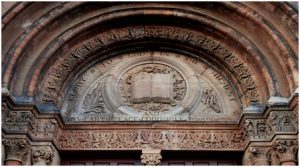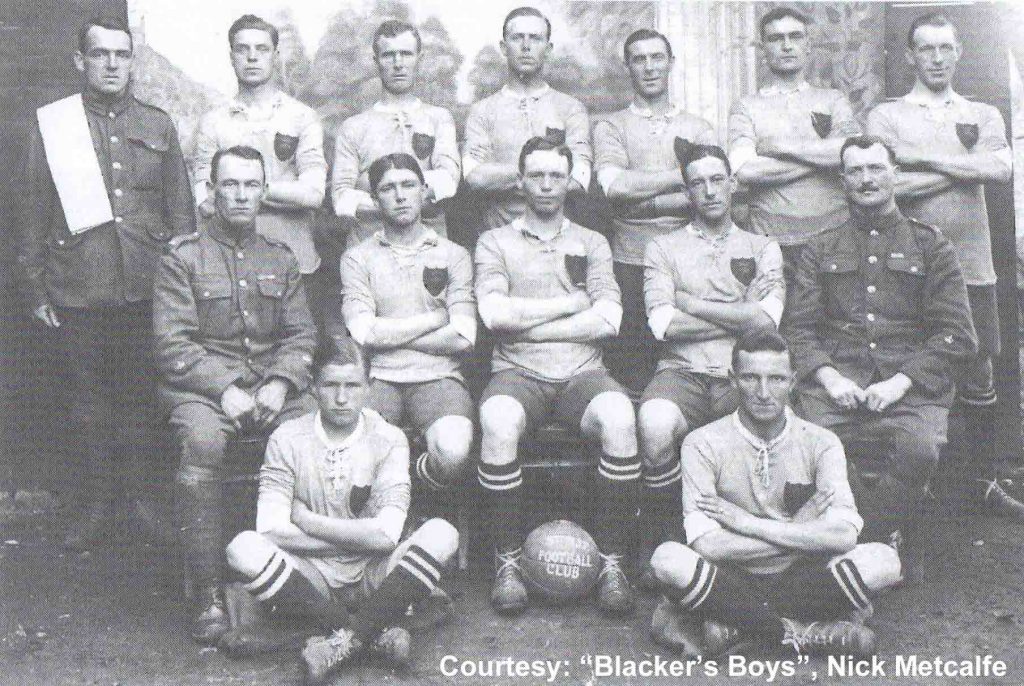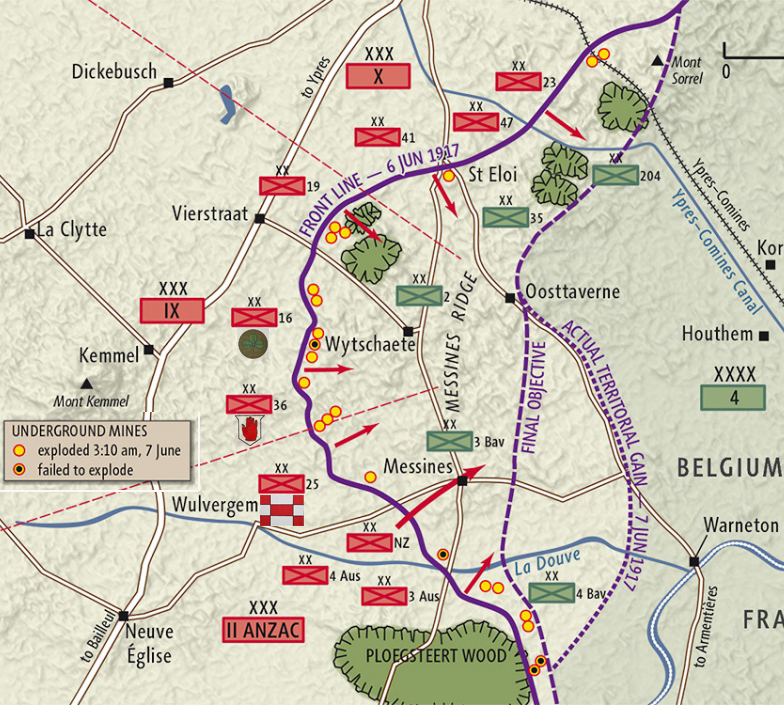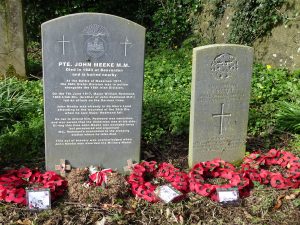Townsend Presbyterian Church 1833 -1970
“Our greatest need is for a larger sense of responsibility for our church and her welfare on the part of every church member and more workers, more people, who are prepared to give their time and talents to the work of God and the service of their fellows in this place.”
(Refer to: Townsend Street Presbyterian Church 150th Anniversary, History of the Congregation, p60)
(Quote by, Rev. John Worthington Johnston. This man of God was installed in the Townsend Presbyterian Church on 28th March 1935. He was a Chaplain in the Parachute Regiment 1939-45. When at war Professor J. Wilson took charge of the congregation. The quote above was written in a letter by the Rev. Captain John Worthington Johnston in 1945. The Rev. Worthington Johnston also wrote a book of poetry called, “The poems of a Parachute Padre”, first published in Belfast in 1943).

The door into the Church – Is still open in 2016
General Timeline for the history of the Townsend Presbyterian Church 1833-1970*
*The Church still continues in its work to the present day
-
- 1833 – October 22nd – The Foundation Stone of the old church building is laid down by the Marquis of Donegall. Rev, George Belis opened the special ceremony, Rev. Dr. Hanna offered up a prayer and Rev. Dr. Henry Cooke delivered an address. Rev. Dr. Morgan concluded with prayer and the benediction. These ministers were all famous figures in 19th Century Belfast.
“The company had not left the ground when there appeared a very beautiful rainbow – one of the most perfect we ever saw – which seemed suspended, as it was undoubtedly over the spot thus dedicated.” Newspaper report quoted in, Rev. James McCaw Townsend Street Presbyterian Church Belfast, 1833-1933, p16.
- 1833 – October 22nd – The Foundation Stone of the old church building is laid down by the Marquis of Donegall. Rev, George Belis opened the special ceremony, Rev. Dr. Hanna offered up a prayer and Rev. Dr. Henry Cooke delivered an address. Rev. Dr. Morgan concluded with prayer and the benediction. These ministers were all famous figures in 19th Century Belfast.
-
- 1835 – April 26th – The church was opened by Rev. Dr. Mcleod of Glasgow
-
- 1836 – Rev. Josias Wilson of Drogheda becomes the first Minister
-
- 1838 – The Church is re-opened by the Rev. Cooke and Rev. Morgan
-
- 1841 – January 21st – The school buildings are opened
-
- 1844 – October 28th – Rev. John Weir of Newry becomes the second Minister
-
- 1847 – September 21st – Rev. William Johnston is installed as the new Minister
-
- 1866 – January 1st – Henry Louden an elder of the church leaves to the church a generous gift of property for the orphans
-
- 1876 – December 4th – The Townsend congregation is worshipping in the Working Men’s Institute as a new church is under construction
-
- 1877 – August 25th – The foundation for the new church is laid and a speech is given by one Mr. John Sinclair from New York
-
- 1877 – September 21st – Lecture hall and school buildings opened

- 1877 – September 21st – Lecture hall and school buildings opened
-
- 1878 – October 9th – The new church was completed and it cost an estimated sum of £11,210 13s 9d
-
- 1879 – January – The Church Gate and the railing at the front of the Church were erected to remember Dr. Henry Martyn Johnston
-
- 1892 – September Rev James McGranahan of Larne becomes the Minister of the Church
-
- 1902 – June 17th Rev William Corkey from Cullybackey becomes the Minister of the Church
-
- 1913 – Individual Communion Cups donated as a gift by Mr. R. McDowell
-
- 1914 – February 8th – Stained Glass windows erected to the memory of Rev. William Johnston and Mrs. Sarah Johnston and to Dr. Henry Martyn Johnston and Mrs Frank Johnston by Mr. R.T. Martin. Further to the memory of Mr. and Mrs. Martin Wallace by Mr. M. Luther Wallace. The windows were unveiled by the Rev. James McGranahan
-
- 1920 – November 1st – Freewill offering system introduced
-
- 1921 – November 13th Opening of Grand Organ and unveiling of Tablets in memory of the men from the Townsend Congregation who had volunteered to fight in the First World War 1914-18. This point is noted in the work Townsend Street Presbyterian Church 150th Anniversary History book, p10. “In the Nation’s hour of need Townsend Street Church played a part worthy of its great history. When the tocsin of war sounded in 1914 some 220 members of the congregation volunteered for active service of whom 36 made the supreme sacrifice. The congregation installed a Memorial Organ and Commemorative Tablet at a cost of £4000.” Quote by Rev. Dr. T.J. Simpson Moderator of the Presbyterian Assembly.
-
 1922 – March 15th – Stained glass window is erected by Mrs. R.T. Martin to the memory of her husband, Mr. R.T. Martin and her son Lieut. John S. Martin. This window was dedicated by the Rev. J.R. Prenter.
1922 – March 15th – Stained glass window is erected by Mrs. R.T. Martin to the memory of her husband, Mr. R.T. Martin and her son Lieut. John S. Martin. This window was dedicated by the Rev. J.R. Prenter.
-
- 1924 – July 9th – Rev. W.G. Wimperis becomes the Minister of the Church
-
- 1930 – July – Restoration of the Church buildings. This is noted in the Church history, “The contractors for the stonework were Messrs. Dreyfus London, for the reconstruction, Messrs. Cairns, Belfast for the painting, Messrs Geo. Morrow and Son, Belfast and for the electrical work, Messrs. Graham and Zebedee, Belfast. Mr. W.J. MacGeagh, Ocean Buildings was the architect.”
(Refer to Townsend Street Presbyterian Street 150th Anniversary History of the Congregation, p46. This was a time in the history of Northern Ireland when there was an economic depression. The church raised in 1930 £5,000. This was quite a feat at the time. “Every organisation in connection with the church did its bit.”)
- 1930 – July – Restoration of the Church buildings. This is noted in the Church history, “The contractors for the stonework were Messrs. Dreyfus London, for the reconstruction, Messrs. Cairns, Belfast for the painting, Messrs Geo. Morrow and Son, Belfast and for the electrical work, Messrs. Graham and Zebedee, Belfast. Mr. W.J. MacGeagh, Ocean Buildings was the architect.”
-
- 1930 – October 30th – The reconstructed buildings are re-opened and used
-
- 1932 – September 29th – Rev J.T. Hall is installed as the new Minister
-
- 1935 – March 5th – Rev. John Worthington Johnston is called to Townsend Street to become the new Minister
-
- 1939 – September 3rd – The Second World War begins. The Rev. J.W. Johnston volunteers for service as a Chaplain in the British Army
-
- 1941 – The air raids over Belfast – The Belfast Blitz impacts upon the City of Belfast with deadly results.

Blue plaque remembering Wilhelmina Geddes
- 1941 – The air raids over Belfast – The Belfast Blitz impacts upon the City of Belfast with deadly results.
-
- 1943 – Rev. J.W. Johnston injured on war service
-
- 1944 – April – The War Memorial Hall Fund is inaugurated
-
- 1951- November 11th – Two War Memorial Tablets unveiled in memory of those who lost their lives by enemy action and to those who served in the War, whose names are inscribed thereon
-
- 1952 – September – Rev. W.D.F. Marshall becomes the Minister of the Church
-
- 1954 – June 6th – A Stained glass window is erected by the congregation to the memory of Rev. J.W. Johnston and is dedicated by the Rev. Principal J. E. Davey
-
- 1965 – January 12th – The Rev. S.J. McCollum is installed as the new minister
-
- 1970 – June 9th – Rev. W.M. Jackson becomes the new Minister
As we have read since, 1833 this Church has worked for God in the area.
By David N.K. Murphy, History Hub Ulster Member




 Another stretcher-bearer from the Ulster Division demonstrated that political allegiance had no place on the battlefield.
Another stretcher-bearer from the Ulster Division demonstrated that political allegiance had no place on the battlefield. 
 Major Redmond to the casualty clearing station located in the Catholic Hospice at Locre but he died later that afternoon. John Meeke’s brother, Samuel, died of acute pulmonary tuberculosis on 19th January 1919, a fortnight after arriving home, and his grave in Derrykeighan Old Graveyard is marked by a Commonwealth War Graves Commission headstone.
Major Redmond to the casualty clearing station located in the Catholic Hospice at Locre but he died later that afternoon. John Meeke’s brother, Samuel, died of acute pulmonary tuberculosis on 19th January 1919, a fortnight after arriving home, and his grave in Derrykeighan Old Graveyard is marked by a Commonwealth War Graves Commission headstone.